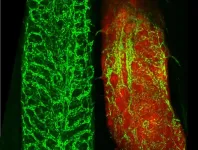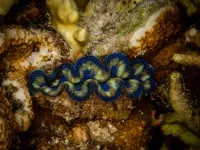(Press-News.org)
Images
There's a famous piece of advice from hockey, attributed to Wayne Gretzky, about how it's better to skate to where the puck is headed rather than where it is.
Research is now showing that regulations designed to protect Lake Erie's water quality are heeding the Great One's words when it comes to safeguarding the Great Lake's fisheries.
Specifically, the currently recommended limits on the flow of nutrients into Lake Erie from agriculture may be too restrictive for some species of fish. They are, however, suited to maintain healthy fisheries until the middle of this century amid a warming climate, according to a new study led by the University of Michigan.
"Hitting the target for the future is the right thing to do now," said Don Scavia, professor emeritus at U-M's School for Environment and Sustainability. "Even though the proposed limits are too much for now, I don't think they should be relaxed because it takes a decade or longer to affect change."
This is but one takeaway from the study led by Scavia with collaborators from across the United States and in Asia.
In the project, the team linked forward-looking climate projections and nearly a century of fishery data with a mathematical model of Lake Erie's nutrient load and a water quality indicator—namely, the oxygen available in the lake's depths.
With all these factors considered, the researchers showed that the relationships aren't as straightforward as the casual observer might expect. For example, while cutting back on nutrients does improve water quality, that doesn't necessarily benefit all fish.
"There are tradeoffs," Scavia said.
And, moving forward, warming temperatures—rather than nutrient load—will become the dominant influence over the oxygen in Lake Erie and similar ecosystems around the world.
Taken altogether, this means that there's no simple solution to managing these ecosystems. And the solutions rolled out today will need to be continuously evaluated and reassessed in the future. In the land management world, this is what's called a "wicked problem."
Fortunately, the team's study provides key insights on how to approach those.
It's complicated
The nutrients in fertilizers that farmers use to feed plants also feed aquatic microorganisms like algae and cyanobacteria. Nutrient-rich runoff water from fields helps fuel the infamous algal blooms in Lake Erie—as well as, for example, in the northern Gulf of Mexico and Chesapeake Bay.
When the algae and cyanobacteria in those blooms die, they sink to the bottom of the water and decompose, consuming enough oxygen in the process to render the water hypoxic. Even underwater, oxygen is essential for life and so hypoxic bottom water regions are often referred to as "dead zones."
Hypoxia is bad news for lake whitefish that prefer the cold bottom water of Lake Erie, said Stuart Ludsin, a professor in the Aquatic Ecology Laboratory at Ohio State University.
But, while the cyanobacteria in algal blooms thrive in fertile, nutrient-rich waters, so too do the plankton that feed the lake's larger fish. And not all of those fish live at depths where hypoxia is a problem. Yellow perch, for instance, actually benefit from water that's richer in nutrients, Ludsin said.
At present, the level of nutrient inputs is beneficial to yellow perch and walleye but limiting bottom habitat for whitefish. Finding the right balance between fishery and water quality considerations is a delicate and ever-moving target, Ludsin said, complicated by the fact that the lake's microbes proliferate faster in warmer temperatures.
"I don't want to see my research being used to say we should pollute to keep the fisheries highly productive," Ludsin said. "If there's no effort to curtail this hypoxia and water quality problem, with continued climate change, the lake will not be able to support vital fish."
The real message, he said, is more nuanced.
"We should try to find the right level of nutrients that will support our water quality goals while supporting the lake's suite of fisheries," Ludsin said.
And what "right" is should be determined by a water system's managers and stakeholders coming together, said Anna Michalak, founding director of Carnegie Science's Climate and Resilience Hub.
By bringing data and tools like the team's model into those discussions, all parties can understand how the best choices for, say, water quality may come at a cost to fisheries, and vice versa.
"The number one takeaway is the importance of approaching these management issues with systems-level thinking. What I mean by that is that there are always going to be tradeoffs depending on what your specific objectives are," said Michalak, who has been collaborating with Scavia for more than a decade studying Lake Erie and other aquatic ecosystems.
"We can't be playing whack-a-mole when it comes to environmental systems. It's only by thinking about them holistically that we can come up with solutions that work."
Although the data and decisions will look different for different ecosystems, this approach is generalizable, the team said.
"I think that this study provides a template and prior knowledge that can be applied to other systems," said Dan Obenour, associate professor of environmental engineering at North Carolina State University. Obenour earned his doctorate at the University of Michigan under the mentorship of Scavia and Michalak.
The study also highlighted that the team's climate-hypoxia model is robust and reliable over long time periods. Combined with the fact that it was designed to be "embarrassingly simple," Michalak said, the model is equipped to be an asset in informing best practices into the future.
"This is a wicked problem," Obenour said. "It's challenging to determine what the best management solution is and, even if you reach a consensus, it's going to change in the future. We need to stay on our toes."
Also contributing to the project were researchers from Heidelberg University in Ohio, Shanghai Jiao Tong University and the Chinese Academy of Sciences.
Study: Water quality-fisheries tradeoffs in a changing climate underscore need for adaptive ecosystem-based management (DOI: 10.1073/pnas.2322595121) (link will be available when embargo lifts)
END
Climate, dead zones and fish: Solving a 'wicked problem' in Lake Erie and beyond
2024-10-28
ELSE PRESS RELEASES FROM THIS DATE:
Dinosaurs thrived after ice, not fire, says a new study of ancient volcanism
2024-10-28
201.6 million years ago, one of the Earth's five great mass extinctions took place, when three-quarters of all living species suddenly disappeared. The wipeout coincided with massive volcanic eruptions that split apart Pangaea, a giant continent then comprising almost all the planet's land. Millions of cubic miles of lava erupted over some 600,000 years, separating what are now the Americas, Europe and North Africa. It marked the end of the Triassic period and the beginning of the Jurassic, the period when dinosaurs arose to take the place of Triassic creatures and dominate the planet.
The exact mechanisms of the End Triassic Extinction have long been debated, ...
Green growth: 30% of regions worldwide achieve economic growth while reducing carbon emissions
2024-10-28
“We found that 30 percent of the regions with available data have fully decoupled carbon emissions from economic growth. Regions with high incomes and a history of carbon-intensive industries, as well as those with significant shares of service and manufacturing sectors were particularly successful in reducing carbon emissions while still experiencing economic growth,“ says Anders Levermann, co-author and head of the research department “Complexity Science” at PIK. “A stabilization of the global mean temperature is only possible with net-zero carbon emissions. That ...
Cellular couriers: Body's ‘delivery trucks’ could lead to new cancer blood test
2024-10-28
A landmark study led by WEHI and La Trobe University has found a potential new diagnostic marker that could be used to better detect the level of tissue damage in our bodies.
Extracellular vesicles (EVs) are small ‘delivery trucks’ released by our cells that deliver important materials to other cells to aid cellular communication. This study revealed, for the first time, a link between levels of EVs in the blood and tissue damage caused by diseases such as leukaemia.
Researchers hope to leverage the ...
Public and community engagement key to enhancing urban living conditions and environmental decision making in China, study says
2024-10-28
Public and community engagement in decision making is key to enhancing urban living conditions and the environment in China, a new study says.
There has been significant progress through legislation to promote the role of citizens in environment and nature-based solutions (NBS), but progress in involving the public in projects has been limited, the research shows.
However, there has been some work in gathering public opinion and involving them in the project design and decision-making of government-led and large NBS projects.
Researchers found smaller local NBS projects tend to see higher levels of public participation, ...
Bagheri to leverage recycled polyurethane foam for real-world applications
2024-10-28
Bagheri To Leverage Recycled Polyurethane Foam For Real-World Applications Shaghayegh Bagheri, Assistant Professor, Mechanical Engineering, College of Engineering and Computing (CEC), received funding for the project: “Leveraging Recycled Polyurethane Foam for Real-world Applications.”
Bagheri ...
Seeing a black hole's jet in a new light
2024-10-28
Image
Research led by the University of Michigan has pored over more than two decades' worth of data from NASA's Chandra X-Ray Observatory to show there's new knotty science to discover around black holes.
In particular, the study looks at the high-energy jet of particles being blasted across space by the supermassive black hole at the center of the galaxy Centaurus A.
Jets are visible to different types of telescopes, including those that detect radio waves and others that collect X-rays. Since Chandra's 1999 launch, many astronomers have been particularly interested ...
Experienced research leader tapped as CEO of Upstate New York Energy Storage Engine led by Binghamton University
2024-10-28
An engineer with decades of experience in industry and higher education will serve as the CEO of the Upstate New York Energy Storage Engine led by Binghamton University.
Meera Sampath, who holds a doctorate in electrical engineering from the University of Michigan, Ann Arbor, previously was the associate dean of research in Binghamton’s Thomas J. Watson College of Engineering and Applied Science.
Sampath spent the first 20 years of her career with Xerox Corp., including time as the vice president for innovation and business transformation at Xerox Services and as founding director of the Xerox Research Center India. From there, she ...
Lewis Katz School of Medicine at Temple University awarded nearly $1 million in PCORI funding to improve antibiotic prescribing for childhood respiratory infections
2024-10-28
(Philadelphia, PA) – A team at the Lewis Katz School of Medicine at Temple University, part of Temple Health, has been awarded nearly $1 million by the Patient-Centered Outcomes Research Institute (PCORI) to help improve antibiotic prescribing for children with acute respiratory tract infections.
“Many children with symptoms of upper respiratory tract illness who are taken to see a pediatrician end up being prescribed antibiotics, even though they aren’t always needed,” explained Janet Lee, MD, Associate Professor of Pediatrics, Lewis Katz School of Medicine. Dr. Lee and Claire Raab, MD, President ...
A new chemistry for CRISPR
2024-10-28
CRISPR-Cas9 has long been likened to a kind of genetic scissors, thanks to its ability to snip out any desired section of DNA with elegant precision.
But it turns out that CRISPR systems have more than one strategy in their toolkit. A mechanism originally discovered in bacteria, where it has operated as an adaptive immune system for eons, CRISPR is naturally deployed by certain singled-cell organisms to protect themselves against viruses (called phages) and other foreign genetic fragments. Now, researchers at Rockefeller’s Laboratory ...
Giant clam declared critically endangered after the latest assessment
2024-10-28
The giant clam, known for its colorful cape-like mantle, wavy shell and astonishing size, is in danger of going extinct after its population plunged by more than 80% over the last century, according to a new assessment by a University of Colorado Boulder biologist and collaborators.
The assessment, led by Ruiqi Li, a postdoctoral researcher at the CU Museum of Natural History, prompted the International Union for Conservation of Nature (IUCN) today to update the conservation status of this animal from “vulnerable” to ...



